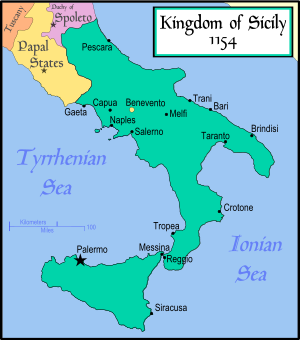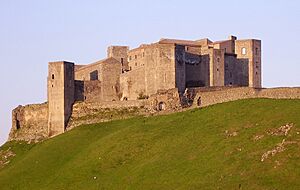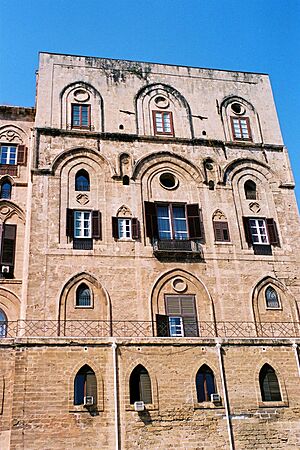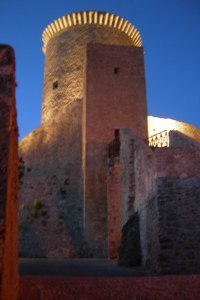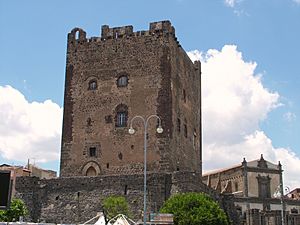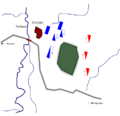Norman conquest of southern Italy facts for kids
The Norman conquest of southern Italy was a long period of history. It lasted from 999 to 1194. Many battles were fought, and different Norman leaders took control of lands.
By 1130, these lands in southern Italy came together. They formed the Kingdom of Sicily. This kingdom included the island of Sicily, the southern part of the Italian Peninsula, and the islands of Malta. It even included some areas in North Africa.
Norman fighters first came to southern Italy as paid soldiers, also called mercenaries. They worked for different groups, like the Lombards and the Byzantine Empire. They quickly sent news back home about new chances in the Mediterranean Sea. These Normans then settled in different places. They created their own small states and became powerful. Within 50 years, they were almost completely independent.
This conquest was different from the Norman Conquest of England in 1066. The English conquest happened quickly after one big battle. But in southern Italy, it took many decades and many battles. Most of these battles were not decisive on their own. Many areas were conquered separately. Later, they were all joined into one kingdom. It was not planned, but it was very successful.
Contents
- How Did Vikings and Normans Get to Italy?
- Lombard Uprising (1009–1022)
- Normans as Mercenaries (1022–1046)
- Norman Power Grows (1046–1059)
- Norman Conquests in Abruzzo (1053–1105)
- How Sicily Was Conquered (1061–1091)
- Conquest of Amalfi and Salerno (1073–1077)
- Byzantine-Norman Wars (1059–1085)
- Conquest of Naples (1077–1139)
- The Kingdom of Sicily (1130–1198)
- Norman Castles and Buildings
- Images for kids
- See also
How Did Vikings and Normans Get to Italy?
Early Viking Visits
There isn't much proof of Vikings in Italy before the Normans arrived in 999. But some raids did happen. Around 860, Viking ships from France sailed to Spain and then to Sicily. A Norman monk wrote that a Viking fleet, possibly led by Björn Ironside, landed in Sicily and conquered it around that time.
Many Norsemen also worked as mercenaries in Southern Italy. This included the Varangian Guard. One famous leader was Harald Hardrada, who later became king of Norway. He helped conquer Sicily between 1038 and 1040. He had help from Norman mercenaries, like William Iron Arm. William got his nickname by defeating the leader of Syracuse in a one-on-one fight.
Later, some English and Norwegian nobles also joined the Norman conquest of southern Italy. For example, Edgar the Ætheling left England in 1086. Jarl Erling Skakke got his nickname ("Skakke," meaning bent head) after a battle in Sicily. On the other hand, many English rebels who were running from William the Conqueror joined the Byzantines. They fought against Robert Guiscard, a Norman duke.
Normans Arrive in Italy

The first time Norman knights are known to have arrived in southern Italy was in 999. Some stories say that Norman pilgrims were returning from Jerusalem. They stopped in Salerno with Prince Guaimar III. The city was being attacked by Saracens who wanted a payment. The Normans thought this was cowardly. They attacked the Saracens, who then ran away.
Prince Guaimar was very thankful. He asked the Normans to stay. They refused but promised to tell their friends in Normandy about the chance for military work in Salerno. Some stories say Guaimar sent people to Normandy to bring back knights. This is known as the "Salerno tradition."
Another story, called the "Gargano tradition," says Norman pilgrims met a Lombard leader named Melus of Bari in 1016. He convinced them to join him in an attack against the Byzantine government in Apulia.
A different story tells of brothers from the Drengot family who had to leave Normandy. One brother, Osmund or Gilbert, had a serious conflict with another person. To avoid punishment, the Drengot brothers fled to Rome. They later joined Melus of Bari.
Between 1016 and 1024, a group of Norman knights led by Gilbert helped Melus. They took control of the County of Ariano. This is thought to be the first area in southern Italy that the Normans officially controlled.
Lombard Uprising (1009–1022)
In 1009, a revolt started in Bari against the Byzantine rulers. It was led by Melus, a local Lombard. The revolt quickly spread. The Byzantine governor was killed in battle. In 1010, a new Byzantine governor arrived with more soldiers. He besieged the rebels in Bari. Melus and his brother-in-law had to escape. The Byzantines took back the city in 1011.
After the Byzantine governor died in 1016, Melus revolted again. This time, he used a new group of Normans. The Normans fought the Byzantines in several battles. Melus won some important victories. By October 1018, the Lombards and Normans had won five battles in a row.
The Byzantines then sent their best soldiers, the Varangian Guard, to Italy. The armies met near Cannae, where Hannibal had won a famous battle long ago. The Battle of Cannae was a big victory for the Byzantines. Only a few Normans survived. After the battle, Ranulf Drengot was chosen as the Normans' new leader. The Byzantines built a fortress at Troia and even used Norman soldiers to guard it. This showed that Normans were willing to fight for either side.
The Pope, who had encouraged the Normans to get involved, became worried. In 1020, he asked Emperor Henry II for help. In 1022, a large imperial army marched south to attack Troia. The fortress did not fall, but the Lombard princes sided with the Emperor. This ended the Lombard revolt.
Normans as Mercenaries (1022–1046)
After the revolt, Norman mercenaries continued to work for different rulers. In 1024, Ranulf Drengot helped Guaimar III of Salerno and Pandulf IV of Capua in a siege. In 1026, Pandulf IV became prince again. Ranulf stayed loyal to Pandulf for a few years. But in 1029, he joined Sergius IV of Naples.
In 1029, Ranulf and Sergius recaptured Naples. In 1030, Sergius gave Ranulf the County of Aversa as a gift. This was one of the first Norman lordships in southern Italy. Ranulf also married Sergius's sister. But when she died in 1034, Ranulf went back to supporting Pandulf. A historian noted that Normans never wanted one side to win completely. They would switch sides to keep things balanced.
More Normans arrived, including Tancred of Hauteville's three oldest sons: William Iron Arm, Drogo, and Humphrey. In 1037 or 1038, Emperor Conrad II made Ranulf the Count of Aversa. Ranulf then expanded his territory by invading Capua.
In 1038, the Byzantine Emperor Michael IV launched a military campaign to take back Sicily from the Muslims. He asked Guaimar IV of Salerno for troops. Guaimar sent 300 Norman knights from Aversa, including the three Hauteville brothers. William of Hauteville became famous as "William Iron Arm" for his bravery. The Normans left the campaign early because they felt they didn't get enough of the spoils.
After a Byzantine leader was killed in 1040, the Normans chose Atenulf, brother of Pandulf III of Benevento as their new leader. In 1041, the Norman army, led by William Iron Arm, defeated the Byzantines twice. A third battle was a big victory for the Normans.
By September 1042, the revolt had become Norman-led. The main Norman groups held a meeting in Melfi. They asked Guaimar IV to recognize their conquests. William Iron Arm was named the Norman leader in Apulia and given the title of Count of Apulia. Guaimar also called himself Duke of Apulia and Calabria. William married Guaimar's niece, which made their alliance stronger.
In 1043, Guaimar divided the region into twelve areas for the Norman leaders. William received Ascoli, Drogo received Venosa, and Ranulf Drengot received Siponto. William and Guaimar began conquering Calabria in 1044. William died soon after, ending the period of Norman mercenary service. Two Norman states emerged: the County of Aversa and the County of Apulia.
Norman Power Grows (1046–1059)
In 1046, Drogo entered Apulia and defeated the Byzantine governor. His brother Humphrey made Bari sign a treaty with the Normans. That same year, Richard Drengot and Robert "Guiscard" Hauteville arrived from Normandy.
In 1047, Guaimar supported Drogo and gave him his daughter in marriage. Emperor Henry III confirmed Drogo's power and made him his vassal. He gave Drogo the title "duke and master of Italy and count of the Normans of all Apulia and Calabria." This was the first official title for the Normans in Melfi. The Emperor also allowed Drogo to conquer Benevento.
In 1048, Drogo led an expedition into Calabria. He gave his brother, Robert Guiscard, a castle at Scribla. Guiscard later moved to a castle at San Marco Argentano. In 1051, Drogo was killed. His brother Humphrey took over.
Humphrey's first challenge was dealing with the Pope. The Normans had treated the Lombards badly, causing more revolts. Pope Leo IX called for an army to remove the Normans from Italy.
On June 18, 1053, Humphrey led the Norman armies against the Pope's forces. At the Battle of Civitate, the Normans crushed the papal army and captured Pope Leo IX. He was held in Benevento. Humphrey died in 1057. His brother Guiscard took over. Guiscard stopped being loyal to the Emperor and instead became loyal to the Pope. In return, he received the title of duke.
Norman Conquests in Abruzzo (1053–1105)
In 1077, the last Lombard prince of Benevento died. In 1078, the Pope appointed Robert Guiscard to take his place. However, Guiscard gave up Benevento in 1081. By then, the area around Benevento was much smaller because of Norman conquests.
After the Battle of Civitate, the Normans began conquering the Adriatic coast of Benevento. Geoffrey of Hauteville, a brother of the Hauteville counts, conquered the Lombard county of Larino. Geoffrey's son, Robert, combined these conquests into a county called Loritello in 1061. He continued to expand into the Abruzzo region. Loritello soon reached as far north as the Pescara River.
The conquest of the Molise region is not well documented. Boiano, the main town, may have been conquered by Robert Guiscard before the Battle of Civitate. The county of Boiano was given to Rudolf of Moulins. His grandson, Hugh, expanded it eastward and westward.
How Sicily Was Conquered (1061–1091)

For about 100 years, Sicily had been ruled by Arabs. When the Normans arrived, the island had a mix of Christians and Muslims. Different Muslim leaders were fighting each other. Into this chaos came the Normans, led by Robert Guiscard and his younger brother Roger Bosso. The Pope had given Robert the title "Duke of Sicily."
Robert and Roger first invaded Sicily in May 1061. They crossed from Calabria and besieged Messina. Roger crossed first, surprising the Saracen army. When Robert's troops landed, they found Messina empty. Robert quickly fortified the city and allied with one of the Muslim leaders. They marched into the center of the island, facing some resistance. They captured Paternò quickly. Robert then went to Castrogiovanni, the strongest fortress. It didn't fall, so Robert returned to Apulia for the winter. Before leaving, he built a fortress at San Marco d'Alunzio. Roger returned later in 1061 and captured Troina. In 1063, he won a battle against a Muslim army at Cerami. This helped the Normans keep their hold on the island.
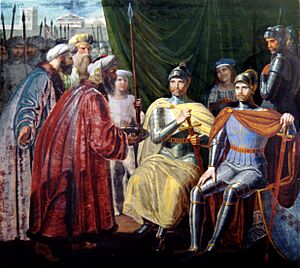
Robert returned in 1064, heading for Palermo, but this campaign was called off. In 1068, Roger won another victory against the Muslims at the Battle of Misilmeri. In August 1071, the Normans began a successful siege of Palermo. The city fell in January 1072. Robert made Roger the Count of Sicily. Robert kept Palermo and half of Messina, giving the rest of the island (including unconquered areas) to Roger.
In 1077, Roger besieged Trapani, one of the last Muslim strongholds in western Sicily. His son, Jordan, surprised the guards and cut off the city's food supply. Trapani soon surrendered. In 1079, Taormina was besieged. In 1081, Jordan and others captured Catania in another surprise attack.
Roger left Sicily in 1083 to help his brother on the mainland. Jordan, whom he had left in charge, revolted. Roger had to return to Sicily to bring his son back under control. In 1085, Roger began a systematic campaign. On May 22, Roger attacked Syracuse by sea. Jordan led soldiers by land. On May 25, the navies fought in the harbor, and the Muslim leader was killed. The siege lasted all summer. When Syracuse surrendered in March 1086, only Noto was still under Muslim rule. In February 1091, Noto also surrendered, and the conquest of Sicily was complete.
In 1091, Roger also invaded Malta. He took control of the city of Mdina. He made the islands pay taxes but allowed the Arab governors to continue ruling. In 1127, Roger II replaced the Muslim government with Norman officials. Under Norman rule, the Arabic language spoken by the Greek Christian islanders for centuries became Maltese.
Conquest of Amalfi and Salerno (1073–1077)
The cities of Amalfi and Salerno fell to Robert Guiscard. His wife, Sichelgaita, played a role. Amalfi likely surrendered because of her talks. Salerno fell when she stopped asking her husband to help her brother, the prince of Salerno. The people of Amalfi tried to avoid Norman rule by asking Prince Gisulf for help. But both states eventually came under Norman control.
By 1076, Gisulf II of Salerno had angered the Normans with his piracy. So, Normans under Richard of Capua and Robert Guiscard besieged Salerno. Gisulf had told his people to store food, but he took most of it for himself. The city surrendered in December 1076. The prince retreated to the citadel, which fell in May 1077. Salerno was the most important city in southern Italy. Capturing it was key to creating the future kingdom.
In 1073, the Duke of Amalfi died. The people of Amalfi asked Robert Guiscard for protection. However, Amalfi remained restless under Norman rule. Robert's son, Roger Borsa, took control of Amalfi in 1089. From 1092 to 1097, Amalfi did not accept Norman rule and seemed to seek Byzantine help.
Robert's son Bohemond and his brother Roger of Sicily attacked Amalfi in 1097 but were pushed back. During this siege, many Normans became interested in the First Crusade. Amalfi revolted again in 1130 when Roger II of Sicily demanded their loyalty. It was finally conquered in 1131.
Byzantine-Norman Wars (1059–1085)
At first, Normans in southern Italy fought alongside the Lombards against the Byzantines. Later, some Normans, like the powerful Hauteville brothers, even served in the Byzantine army. But they eventually turned against their Byzantine employers. By 1030, Rainulf became count of Aversa, starting permanent Norman settlement in Italy. In 1042, William Iron Arm became a count, loyal to the Lombard prince Guaimar IV of Salerno. To make their ties stronger, Robert Guiscard married the Lombard Princess Sikelgaita in 1058. After Guaimar died, the Normans became more independent. This led to direct conflict with the Byzantine Empire.
While the Normans were conquering southern Italy, the Byzantine Empire was weakening. Its government and military were in decline. The Normans took advantage of this to strengthen their hold on Sicily and Italy.
Reggio Calabria, the capital of Calabria, was captured by Robert Guiscard in 1060. The Byzantines still held a few coastal towns in Apulia, including Bari. In 1067–68, they supported a rebellion against Guiscard. In 1068, the Normans besieged Otranto. That same year, they began the siege of Bari itself. After defeating the Byzantines in several battles, Bari surrendered in April 1071. This ended the Byzantine presence in southern Italy.
From 1061 to 1091, Norman groups also finished what the Byzantines had tried to do: retake Sicily. However, it wasn't until 1130 that Sicily and southern Italy were united into one kingdom by Roger II of Sicily.
Conquest of Naples (1077–1139)
The Duchy of Naples was officially a Byzantine territory. It was one of the last southern Italian states attacked by the Normans. Since the 1020s, the dukes of Naples had usually been allied with the Normans of Aversa and Capua. It took 60 years, starting in 1077, for Naples to become part of the Norman state.
In 1074, fighting broke out between Richard of Capua and Robert Guiscard. Sergius V of Naples allied with Guiscard, making Naples a supply center for his troops. This put Naples against Richard. Richard briefly besieged Naples.
In 1077, Naples was again besieged by Richard of Capua, with Robert Guiscard blocking the sea. Richard died during the siege in 1078. His successor, Jordan, ended the siege to make peace with the Pope.
In 1130, Antipope Anacletus II crowned Roger II of Sicily king. He declared Naples part of Roger's kingdom. In 1131, Roger demanded control of Amalfi. When they refused, Sergius VII of Naples prepared to help them. But Roger's fleet blocked Naples' port. Sergius gave in to Roger. A historian wrote that Naples, which had rarely been conquered by force, now submitted to Roger just because Amalfi had fallen.
In 1134, Sergius supported a rebellion against Roger II. But he avoided direct fighting and paid respect to Roger after Capua fell. In 1135, a fleet from Pisa arrived in Naples with reinforcements. Naples became the center of the revolt against Roger II for the next two years. Sergius and the rebels were besieged in Naples until spring 1136. People were starving. A historian wrote that they preferred to die of hunger than surrender to Roger. When an army led by Emperor Lothair II marched to Naples, the siege was lifted.
Although the emperor left the next year, Sergius again submitted to Roger. On October 30, 1137, the last Duke of Naples died in battle. This defeat allowed the Norman conquest of Naples. Sergius died without an heir. The nobles of Naples couldn't agree on a new ruler. For two years, the nobility seemed to rule Naples independently. In 1139, Roger finally took Naples into his kingdom. The Pope and the Neapolitan nobles recognized Roger's young son, Alfonso of Hauteville, as duke.
The Kingdom of Sicily (1130–1198)
While the conquest of Sicily involved fighting, Robert and Roger also made agreements with Muslim leaders. Sicily's hilly land and their smaller army meant they often sought out tired Muslim leaders. They offered peace and protection in exchange for land and titles. Because Roger conquered Sicily with a single command, his power was not challenged by other Norman leaders. He kept control over his Greek, Arab, Lombard, and Norman people.
Latin Christianity was brought to the island. Roger, with the Pope's approval, set up new church areas. After it became the Kingdom of Sicily in 1130, Sicily became the main center of Norman power. Palermo was its capital. The Kingdom was created on Christmas Day, 1130, by Roger II. He had the agreement of Pope Innocent II. Roger united the lands he had inherited from his father, Roger I.
These areas included the Maltese Archipelago, which was taken from the Arabs. It also included the Duchy of Apulia and the County of Sicily. These had belonged to his cousin William II until William died in 1127. Other Norman vassals also became part of the kingdom.
Later, Emperor Henry VI invaded the kingdom. He did this for his wife, Constance, who was Roger II's daughter. The kingdom fell to the House of Hohenstaufen in 1194. Through Constance, the Hauteville bloodline passed to Frederick II, Holy Roman Emperor. He became King of Sicily in 1198.
Norman Castles and Buildings
The Norman conquest of southern Italy brought new building styles, especially Romanesque (Norman) architecture. Some castles were built on top of older Lombard, Byzantine, or Arab structures. Others were completely new. Latin cathedrals were built in areas that had recently changed from Byzantine Christianity or Islam. These cathedrals mixed Romanesque, Byzantine, and Islamic designs.
Public buildings, like palaces, were common in larger cities, especially Palermo. These buildings show the mix of Norman, Sicilian, and Arab cultures.
The Normans quickly started building, expanding, and fixing castles. By the end of the Norman period, most wooden castles were rebuilt with stone.
Calabria was one of the first areas to see Norman castle building. In 1046, William Iron Arm began building Stridula, a large castle. By 1055, Robert Guiscard built three castles: at Rossano, Scribla, and San Marco Argentano. In 1058, Scalea was built on a cliff by the sea.
Guiscard built many castles after becoming Count of Apulia. He built a castle at Gargano with unique pentagonal towers. In the Molise region, the Normans built many fortresses in the naturally protected terrain. Many of these sites were old strongholds used by earlier peoples. The Normans called these "old castles." Many castles in Molise have walls built into the mountains.
The building of castles in Sicily began when the local Greek people asked Guiscard for one. In 1060, the first Norman building on Sicily, San Marco d'Alunzio, was built. Its ruins still stand. Then castles were built at Petralia Soprana, Troina (in 1071), Mazara (in 1073), and Paternò. At Adrano, the Normans built a simple, rectangular tower. Its design shows how Norman buildings looked in the 11th century.
Images for kids
See also
- Vikings
- Normans
- Byzantine-Norman Wars
- First Crusade


